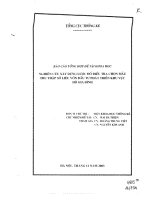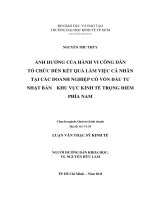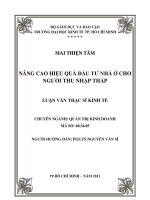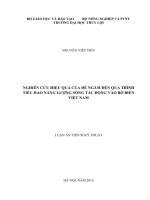TÁC ĐỘNG CỦA DÒNG VỐN FDI LÊN ĐẦU TƯ TƯ NHÂN Ở KHU VỰC ĐÔNG NAM BỘ CỦA VIỆT NAM
Bạn đang xem bản rút gọn của tài liệu. Xem và tải ngay bản đầy đủ của tài liệu tại đây (343.9 KB, 11 trang )
<span class='text_page_counter'>(1)</span><div class='page_container' data-page=1>
<b>THE EFFECT OF FDI ON PRIVATE INVESTMENT IN THE </b>
<b>SOUTHEAST REGION OF VIETNAM </b>
<b>Nguyen Van Bona*</b>
<i>a<sub>The Faculty of Finance-Banking, University of Finance Marketing (UFM), Ho Chi Minh City, Vietnam </sub></i>
<i>*<sub>Corresponding author: Email: </sub></i>
<b>Article history </b>
Received: August 24th<sub>, 2020 </sub>
Received in revised form: October 25th<sub>, 2020 | Accepted: October 28</sub>th<sub>, 2020 </sub>
<b>Abstract </b>
<i>The Southeast region of Vietnam is the most dynamic economic area of the country and </i>
<i>contributes the most to state budget revenue. Every year, this area attracts a high volume of </i>
<i>foreign direct investment (FDI) inflows with the establishment of more industrial zones, </i>
<i>export processing zones, and high technology parks. Do FDI inflows into this area crowd </i>
<i>out/in private investment? This study uses the general method of moments (GMM) </i>
<i>Arellano-Bond estimator to empirically investigate the effect of FDI inflows on private investment in </i>
<i>the Southeast region from 2005 to 2018. The FE-IV estimator is employed to check the </i>
<i>robustness of the estimates. The results show that FDI inflows crowd in private investment </i>
<i>in this area. In addition, inflation increases private investment but infrastructure decreases </i>
<i>it. The findings in this study provide some crucial policy implications for local governments </i>
<i>in the Southeast region to attract more FDI inflows and stimulate more private investment. </i>
<b>Keywords: FDI; FE-IV estimator; GMM estimator; Private investment; Southeast region of </b>
Vietnam.
DOI:
Article type: (peer-reviewed) Full-length research article
Copyright © 2020 The author(s).
</div>
<span class='text_page_counter'>(2)</span><div class='page_container' data-page=2>
<b>TÁC ĐỘNG CỦA DÒNG VỐN FDI LÊN ĐẦU TƯ TƯ NHÂN Ở KHU </b>
<b>VỰC ĐÔNG NAM BỘ CỦA VIỆT NAM </b>
<b>Nguyễn Văn Bổna*</b>
<i>a<sub>Khoa Tài chính-Ngân hàng, Trường Đại học Tài chính Marketing (UFM), TP. Hồ Chí Minh, Việt Nam </sub></i>
<i>*<sub>Tác giả liên hệ: Email: </sub></i>
<b>Lịch sử bài báo </b>
Nhận ngày 24 tháng 8 năm 2020
Chỉnh sửa ngày 25 tháng 10 năm 2020 | Chấp nhận đăng ngày 28 tháng 10 năm 2020
<b>Tóm tắt </b>
<i>Khu vực Đơng Nam Bộ của Việt Nam là khu vực kinh tế năng động nhất và đóng góp phần </i>
<i>lớn ngân sách thu được của nhà nước. Mỗi năm, khu vực này thu hút một lượng lớn dịng </i>
<i>vốn đầu tư FDI với sự hình thành nhiều khu công nghiệp, khu chế xuất, và các công viên </i>
<i>cơng nghệ cao. Liệu dịng vốn FDI đổ vào khu vực này chèn lấn/thúc đẩy đầu tư tư nhân? </i>
<i>Bài viết này sử dụng phương pháp ước lượng GMM Arellano-Bond để đánh giá thực nghiệm </i>
<i>tác động của dòng vốn FDI lên đầu tư tư nhân ở khu vực Đông Nam Bộ từ 2005 đến 2018. </i>
<i>Phương pháp ước lượng FE-IV được sử dụng để kiểm tra tính bền của các ước lượng. Các </i>
<i>kết quả cho thấy dòng vốn FDI thúc đẩy đầu tư tư nhân ở khu vực này. Ngoài ra, lạm phát </i>
<i>làm tăng đầu tư tư nhân nhưng cơ sở hạ tầng làm giảm nó. Các phát hiện trong nghiên cứu </i>
<i>này cung cấp một vài hàm ý chính sách quan trọng cho các chính quyền địa phương trong </i>
<i>khu vực Đông Nam Bộ thu hút nhiều dòng vốn FDI hơn và thúc đẩy nhiều hơn đầu tư tư </i>
<i>nhân. </i>
<b>Từ khóa: Đầu tư tư nhân; FDI; Khu vực Đông Nam Bộ của Việt Nam; Phương pháp ước </b>
lượng FE-IV; Phương pháp ước lượng GMM.
DOI:
Loại bài báo: Bài báo nghiên cứu gốc có bình duyệt
Bản quyền © 2020 (Các) Tác giả.
</div>
<span class='text_page_counter'>(3)</span><div class='page_container' data-page=3>
<b>1. </b> <b>INTRODUCTION </b>
The foreign direct investment (FDI)–private investment relationship leads to
opposing views among economists and policy-makers. Stemming from Agosin and
Machado (2005), a new research strand on this topic has investigated this relationship in
an attempt to examine substitutability or complementarity. FDI is a source of investment
capital that greatly contributes to economic growth and development in countries
worldwide. Agosin and Machado (2005) argue that FDI is a fixed kind of international
business activity mostly set up by transnational enterprises in which foreign investors get
benefits from popularizing their brand name, advertising, marketing, and selling their
products and services in other countries, especially host countries. Khan and Reinhart
(1990) find that private investment plays an outstanding role in promoting economic
development and growth, creating employment, and thus improving social security.
FDI has both positive and negative effects on private investment despite its
important role in the economic development of host countries. On one side, FDI inflows
can encourage private investment through opportunities for cooperation. One example is
an investment joint venture between domestic investors and foreign enterprises. In some
cases, domestic investors may supply raw materials and do outwork for FDI enterprises
and receive and learn advanced technologies from these enterprises to lower production
costs. This is an example of the crowding-in impact of FDI on private investment (Agosin
& Machado, 2005). On the other side, upward pressure on interest rates will occur in host
countries if FDI enterprises use domestic credit to finance their business activities,
thereby making domestic enterprises give up potential business opportunities. This is an
example of the crowding-out impact of FDI inflows on private investment (Delgado &
McCloud, 2017).
The Southeast region is considered a key economic zone with its most dynamic
development in Ho Chi Minh City. It is the most developed economic region in Vietnam,
contributing more than two-thirds of the annual budget revenue and having an
urbanization rate of 50% (HIDS, 2020). The lack of investment capital in this region is
partly compensated by attracting FDI inflows from other countries around the world with
the incentive policies and regulations of local governments. It leads to the formation of
high technology parks, export processing zones, and industrial zones. Meanwhile, the
private sector plays an important role in this region with a high share of GDP and a high
rate of job creation. However, with incentive policies such as tax reduction, cheap land
lease, and convenient administrative procedures, whether FDI inflows will crowd out
private investment in this region or not is the main objective of this study.
</div>
<span class='text_page_counter'>(4)</span><div class='page_container' data-page=4>
The remainder of the paper is structured in the following way. The literature
review in Section 2 presents the effect of FDI inflows on private investment. Section 3
describes the appropriate features of the D-GMM and FE-IV estimators via model
specification and research data. The D-GMM estimates and the robustness check by the
FE-IV estimator are given in Section 4 (empirical results). Section 5 summarizes the
results and provides some important policy implications.
<b>2. </b> <b>LITERATURE REVIEW </b>
In the relevant literature, some studies support the crowd-out hypothesis while
others provide empirical evidence to demonstrate the crowd-in hypothesis. Still others
indicate mixed evidence on the effect of FDI inflows on private investment.
Regarding the crowd-out hypothesis, Farla, de Crombrugghe, and Verspagen
(2016) and Morrissey and Udomkerdmongkol (2012) are among the primary
contributions. These studies empirically investigate the influences of governance
environment, FDI, and their interactions on private investment for a group of 46
developing countries by applying the one-step system GMM Arellano-Bond estimator.
Both studies provide evidence that FDI inflows reduce private investment. Other studies,
Eregha (2012); Kim and Seo (2003); Mutenyo, Asmah, and Kalio (2010); Szkorupová
(2015); and Titarenko (2006), also find that FDI inflows decrease private investment.
Wang (2010) notes that FDI reduces private investment but finds, using estimators of
random effects, fixed effects, and GMM Arellano-Bond, that cumulative FDI stimulates
it. Similarly, Pilbeam and Oboleviciute (2012) use the one-step GMM estimator for a
sample of 26 EU countries from 1990 to 2008 and note a crowding-out impact of FDI on
domestic investment for the older EU14 member states.
</div>
<span class='text_page_counter'>(5)</span><div class='page_container' data-page=5>
Some investigators show mixed results for the relationship between FDI inflows
and private investment (Agosin & Machado, 2005; Ahmed, Ghani, Mohamad, & Derus,
2015; Apergis, Katrakilidis, & Tabakis, 2006; Onaran, Stockhammer, & Zwickl, 2013;
Mišun & Tomšk, 2002). Lin and Chuang (2007), using a Heckman two-stage least squares
(2SLS) estimator, find that FDI increases domestic investment of larger firms and
decreases it for smaller firms in Taiwan (R.O.C) over 1993-1995 and 1997-1999.
Similarly, Tan, Goh, and Wong (2016), using the PMG estimator, find that FDI has a
crowding-in influence on gross private investment over the long run for a group of eight
ASEAN economies from 1986 to 2011. In addition, using the ARDL test, Chen, Yao, and
Malizard (2017) confirm that FDI inflows have a neutral relationship with private
investment in China from Q1/1994 to Q4/2014. By regarding the entry mode set up by
FDI enterprises, they find that wholly foreign-funded FDI inflows crowd out private
investment, but equity joint venture FDI inflows crowd in.
<b>3. </b> <b>MODEL SPECIFICATION AND RESEARCH DATA</b>
<b>3.1. Model specification </b>
From the empirical model of Agosin and Machado (2005), we extend the
empirical equation as follows:
𝑃𝐼𝑁𝑖𝑡 = 𝛽0+ 𝛽1𝑃𝐼𝑁𝑖𝑡−1+ 𝛽2𝐹𝐷𝐼𝑖𝑡+ 𝑋𝑖𝑡𝛽′+ 𝜂𝑖 + 𝜉𝑖𝑡 (1)
<i>where subscripts t and i are the time and province index, respectively. FDIit</i> is net
<i>FDI inflow (% GDP), PINit is private investment (% GDP), and PINit-1</i> is the lagged
<i>variable (the initial level of private investment). Xit</i> is a set of control variables such as
<i>inflation, labor force, and infrastructure. ζit is an observation-specific error term while ηi</i>
<i>is an unobserved province-specific, time-invariant effect, and β0, β1, β2, and β´ are </i>
estimated coefficients.
Some serious problems of econometrics emerge from estimating Equation (1).
<i>First, the presence of the lagged dependent variable PINit-1</i> can lead to a high
autocorrelation. Second, some variables such as labor force and inflation may be
<i>endogenous because they can correlate with the error term ηi</i>. Third, the panel data has a
short observation length (T = 14) and a small number of provinces (N = 6). Finally, some
unobserved time-invariant, province-specific characteristics like geography and
anthropology can correlate with the independent variables. These fixed effects exist in
<i>the error term ηi</i> and may make the OLS estimator inconsistent and biased. The
</div>
<span class='text_page_counter'>(6)</span><div class='page_container' data-page=6>
We apply the GMM (general method of moments) Arellano and Bond (1991)
estimator first suggested by Holtz-Eakin, Newey, and Rosen (1988) to estimate Equation
(1). Being a dynamic model, Equation (1) is taken in the first difference to eliminate
province-specific effects. Next, we use the regressors in the first difference as
instrumented by their lags with the condition that time-varying residuals in the original
equations are not serially correlated (Judson & Owen, 1999).
The empirical model uses the Arellano-Bond and Sargan statistics to assess the
validity of instruments in D-GMM. The Sargan tests with null hypothesis H0: the
instrument is strictly exogenous, which implies that it does not correlate with errors. In
addition, the Arellano-Bond tests are applied to search the autocorrelation of errors in the
first difference. Thus, the test result of errors in the first difference, AR(1) is ignored but
the autocorrelation of errors in the second difference, AR(2) is tested to search the ability
of the first autocorrelation of errors, AR(1). Meanwhile, the FE-IV estimator is the
instrumental variable regression for panel data with fixed effects in which the variables
can be endogenous (Baum, Schaffer, & Stillman, 2007). The validity of instruments in
the FE-IV estimator is also assessed through the Sargan statistic.
<b>3.2. Research data </b>
The main variables, private investment, FDI, labor force, consumer price index,
and infrastructure, are extracted from the General Statistics Office of Vietnam (2020).
The research sample contains balanced panel data of six provinces in the Southeast region
(Binh Phuoc, Tay Ninh, Dong Nai, Binh Duong, Ba Ria Vung Tau, and Ho Chi Minh
City) over the period 2005-2018.
The descriptive statistics are given in Table 1. The results show the average
private investment in the period from 2005 to 2018 in the Southeast region is 15.193%
with the lowest of 0.793% in Ba Ria-Vung Tau in 2007 and the highest of 36.971% in
Binh Duong in 2005. Similarly, the average FDI in this region in the same period is
10.792% with the lowest being 0.49% in Ho Chi Minh City in 2016 and the highest being
48.460% in Binh Duong in 2006. The matrix of correlation coefficients is presented in
Table 2. Labor force is positively connected with private investment while infrastructure
is negatively linked to it. Correlation coefficients in Table 2 have values lower than 0.800,
which removes the possibility of colinearity between variables in the empirical models.
<b>Table 1. Descriptive statistics </b>
</div>
<span class='text_page_counter'>(7)</span><div class='page_container' data-page=7>
<b>Table 2. The matrix of correlation coefficients </b>
PIN FDI LAB INF TEL
PIN 1.000
FDI 0.174 1.000
LAB 0.228** <sub>0.437</sub>*** <sub>1.000 </sub>
INF 0.163 0.163 -0.099 1.000
TEL -0.389*** <sub>0.085 </sub> <sub>-0.355</sub>*** <sub>0.465</sub>*** <sub>1.000 </sub>
Notes: ***<sub>, </sub>**<sub>, and </sub>*<sub>denote significance at 1%, 5%, and 10%, respectively. </sub>
<b>4. </b> <b>EMPIRICAL RESULTS </b>
<b>4.1. D-GMM estimates </b>
Table 3 presents the results estimated by D-GMM. Column 3 is the full model,
while the reduced models without one and two variables, respectively, are given in
Columns 1 and 2. Indeed, some variables are ruled out of the model to test the reliability
of the estimated coefficients. The estimated results indicate that the significance, size, and
sign of coefficients of FDI, inflation, and infrastructure are nearly unchanged.
Infrastructure is detected to be endogenous in the estimation procedure, so the lags of
infrastructure are used as instrumented while the remaining variables (private investment,
FDI, labor force, and inflation) are used as instruments. Meanwhile, the Sargan tests in
Table 3 show that the set of instruments is valid, and the Arellano-Bond AR(2) tests
confirm no autocorrelation of the second order. Therefore, the model specification turns
out to be reliable.
</div>
<span class='text_page_counter'>(8)</span><div class='page_container' data-page=8>
<b>Table 3. FDI and private investment: D-GMM, 2005-2018 </b>
Variables Model 1 Model 2 Model 3
Private investment (-1) -0.009
(0.104)
0.029
(0.105)
0.032
(0.106)
FDI 0.627***
(0.086)
0.584***
(0.087)
0.592***
(0.090)
Labor force 0.068
(0.163)
Inflation 0.117**
(0.056)
0.121**
(0.058)
Infrastructure -0.025***
(0.006)
-0.031***
(0.007)
-0.031***
(0.007)
Observation 60.000 60.000 60.000
AR(2) test 0.102 0.139 0.139
Sargan test 0.537 0.736 0.669
Notes: ***<sub>, </sub>**<sub>, and </sub>*<sub>denote significance at 1%, 5%, and 10%, respectively; </sub>
Dependent variable: Private investment (% GDP).
<b>4.2. Robustness check </b>
To test the robustness of the estimates, we apply the FE-IV estimator to
re-estimate Equation (1). In line with D-GMM, the re-estimated results show that FDI crowds
in private investment, supporting the “crowd-in hypothesis.” Besides, inflation also
stimulates private investment but infrastructure reduces it.
<b>Table 4. FDI and private investment: FE-IV, 2005-2018 </b>
Variables Coefficients
Private investment (-1) 0.487
(0.084)
FDI 0.239 ***
(0.065)
Labor force 0.045
(0.089)
Inflation 0.144 **
(0.064)
Infrastructure -0.020***
(0.007)
Observation 78.000
Sargan test 1.644
Notes: ***<sub>, </sub>**<sub>, and </sub>* <sub>denote significance at 1%, 5%, and 10%, respectively; </sub>
</div>
<span class='text_page_counter'>(9)</span><div class='page_container' data-page=9>
<b>5. </b> <b>CONCLUSIONS AND POLICY IMPLICATIONS </b>
Motivated by the fact that the Southeast region is considered one of the most
dynamic areas that attract high FDI inflows, and in particular, no investigation on the
relationship between FDI inflows and private investment has been carried out for this
area, the study empirically examines the effect of FDI on private investment for a sample
of six provinces in this area from 2005 to 2018 using the difference GMM Arellano-Bond
estimator. The FE-IV estimator is applied to check the robustness of estimates. The
empirical results indicate that FDI crowds in private investment. In addition, inflation and
infrastructure are significant determinants of private investment in this area.
These findings suggest that policies and regulations in this area are appropriate in
attracting FDI inflows from around the world, which promotes the investment activities
of the private sector. However, some problems such as pollution, transfer pricing, and tax
evasion caused by FDI enterprises also cause concerns. Therefore, the Southeast region
as well as Vietnam needs to reform policies and regulations to attract more green FDI
inflows to ensure sustainable development in the future.
<b>ACKNOWLEDGEMENTS </b>
This work was financially supported by the Sai Gon University under grant.
<b>REFERENCES</b>
Adams, S. (2009). Foreign direct investment, domestic investment, and economic growth
<i>in Sub-Saharan Africa. Journal of Policy Modeling, 31(6), 939-949. </i>
Agosin, M. R., & Machado, R. (2005). Foreign investment in developing countries: Does
<i>it crowd in domestic investment? Oxford Development Studies, 33(2), 149-162. </i>
Ahmed, K. T., Ghani, G. M., Mohamad, N., & Derus, A. M. (2015). Does inward FDI
<i>crowd-out domestic investment? Evidence from Uganda. Procedia-Social and </i>
<i>Behavioral Sciences, 172, 419-426. </i>
Al-Sadig, A. (2013). The effects of foreign direct investment on private domestic
<i>investment: Evidence from developing countries. Empirical Economics, 44(3), </i>
1267-1275.
Ang, J. B. (2009). Do public investment and FDI crowd in or crowd out private domestic
<i>investment in Malaysia? Applied Economics, 41(7), 913-919. </i>
Ang, J. B. (2010). Determinants of private investment in Malaysia: What causes the
<i>postcrisis slumps? Contemporary Economic Policy, 28(3), 378-391. </i>
Apergis, N., Katrakilidis, C. P., & Tabakis, N. M. (2006). Dynamic linkages between FDI
<i>inflows and domestic investment: A panel cointegration approach. Atlantic </i>
</div>
<span class='text_page_counter'>(10)</span><div class='page_container' data-page=10>
Arellano, M., & Bond, S. (1991). Some tests of specification for panel data: Monte Carlo
<i>evidence and an application to employment equations. The Review of Economic </i>
<i>Studies, 58(2), 277-297. </i>
Baum, C. F., Schaffer, M. E., & Stillman, S. (2007). Enhanced routines for instrumental
<i>variables/generalized method of moments estimation and testing. The Stata </i>
<i>Journal, 7(4), 465-506. </i>
Boateng, E., Amponsah, M., & Baah, C. A. (2017). Complementarity effect of financial
development and FDI on investment in Sub‐Saharan Africa: A panel data
<i>analysis. African Development Review, 29(2), 305-318. </i>
Chen, G. S., Yao, Y., & Malizard, J. (2017). Does foreign direct investment crowd in or
crowd out private domestic investment in China? The effect of entry
<i>mode. Economic Modelling, 61, 409-419. </i>
Delgado, M. S., & McCloud, N. (2017). Foreign direct investment and the domestic
<i>capital stock: The good-bad role of higher institutional quality. Empirical </i>
<i>Economics, 53(4), 1587-1637. </i>
Desai, M. A., Foley, C. F., & Hines Jr, J. R. (2005). Foreign direct investment and the
<i>domestic capital stock. American Economic Review, 95(2), 33-38. </i>
Eregha, P. B. (2012). The dynamic linkages between foreign direct investment and
domestic investment in ECOWAS countries: A panel cointegration
<i>analysis. African Development Review, 24(3), 208-220. </i>
Farla, K., de Crombrugghe, D., & Verspagen, B. (2016). Institutions, foreign direct
<i>investment, and domestic investment: Crowding out or crowding in? World </i>
<i>Development, 88, 1-9. </i>
General Statistics Office of Vietnam (2020). Retrieved from
[Accessed online 2020, February 8th].
HIDS (2020). Retrieved from Chi Minhcity.gov.vn/web/guest/home.
[Accessed online 2020, February 8th].
Holtz-Eakin, D., Newey, W., & Rosen, H. S. (1988). Estimating vector autoregressions
<i>with panel data. Econometrica, 56(6), 1371-1395. </i>
Jin, J., & Zou, H. F. (2005). Fiscal decentralization, revenue and expenditure assignments,
<i>and growth in China. Journal of Asian Economics, 16(6), 1047-1064. </i>
Jude, C. (2018). Does FDI crowd out domestic investment in transition
<i>countries? Economics of Transition and Institutional Change, 27(1), 163-200. </i>
Judson, R. A., & Owen, A. L. (1999). Estimating dynamic panel data models: A guide
<i>for macroeconomists. Economics Letters, 65(1), 9-15. </i>
Khan, M. S., & Reinhart, C. M. (1990). Private investment and economic growth in
<i>developing countries. World Development, 18(1), 19-27. </i>
</div>
<span class='text_page_counter'>(11)</span><div class='page_container' data-page=11>
Lin, H. L., & Chuang, W. B. (2007). FDI and domestic investment in Taiwan: An
<i>endogenous switching model. The Developing Economies, 45(4), 465-490. </i>
Mišun, J., & Tomšk, V. (2002). Does foreign direct investment crowd in or crowd out
<i>domestic investment? Eastern European Economics, 40(2), 38-56. </i>
Morrissey, O., & Udomkerdmongkol, M. (2012). Governance, private investment and
<i>foreign direct investment in developing countries. World Development, 40(3), </i>
437-445.
Munemo, J. (2014). Business start-up regulations and the complementarity between
<i>foreign and domestic investment. Review of World Economics, 150(4), 745-761. </i>
Mutenyo, J., Asmah, E., & Kalio, A. (2010). Does foreign direct investment crowd-out
<i>domestic private investment in Sub-Saharan Africa? African Finance </i>
<i>Journal, 12(1), 27-52. </i>
Ndikumana, L., & Verick, S. (2008). The linkages between FDI and domestic investment:
Unravelling the developmental impact of foreign investment in Sub‐Saharan
<i>Africa. Development Policy Review, 26(6), 713-726. </i>
Onaran, Ö., Stockhammer, E., & Zwickl, K. (2013). FDI and domestic investment in
<i>Germany: Crowding in or out? International Review of Applied Economics, 27(4), </i>
429-448.
Pilbeam, K., & Oboleviciute, N. (2012). Does foreign direct investment crowd in or
<i>crowd out domestic investment? Evidence from the European Union. The Journal </i>
<i>of Economic Asymmetries, 9(1), 89-104. </i>
Prasanna, N. (2010). Direct and indirect impact of foreign direct investment (FDI) on
<i>domestic investment (DI) in India. Journal of Economics, 1(2), 77-83. </i>
Szkorupová, Z. (2015). Relationship between foreign direct investment and domestic
<i>investment in selected countries of Central and Eastern Europe. Procedia </i>
<i>Economics and Finance, 23, 1017-1022. </i>
Tan, B. W., Goh, S. K., & Wong, K. N. (2016). The effects of inward and outward FDI
on domestic investment: Evidence using panel data of ASEAN–8
<i>countries. Journal of Business Economics and Management, 17(5), 717-733. </i>
Tang, S., Selvanathan, E. A., & Selvanathan, S. (2008). Foreign direct investment,
domestic investment and economic growth in China: A time series
<i>analysis. World Economy, 31(10), 1292-1309. </i>
Titarenko, D. (2006). The influence of foreign direct investment on domestic investment
<i>processes in Latvia. Transport and Telecommunication, 7(1), 76-83. </i>
</div>
<!--links-->
<a href=' /> giải pháp mở rộng tín dụng ngắn hạn tại chi nhánh – ngân hàng đầu tư & phát triển khu vực gia lâm
- 51
- 173
- 0








